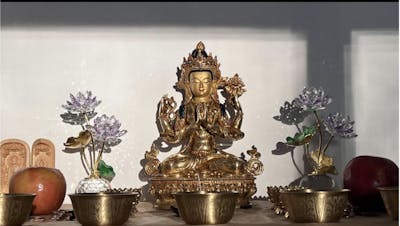-
Mother Green Tara Statue: A Spiritual Masterpiece for DevoteesRegular price $6,210.00
$6,900.00Sale price -
-
-
-
Luxurious Green Tara Statue: A Masterpiece for Spiritual PractitionersRegular price $2,475.00
$2,750.00Sale price -
Green Tara Deity Statue : Serene and Sacred Spiritual DécorRegular price $2,063.70
$2,293.00Sale price -
-
Authentic & Elegant Goddess Tara Statue: Majestic Work of ArtRegular price $1,890.00
$2,100.00Sale price -
Beautifully Handcrafted Green Hue Green Tara Statue with Golden FaceRegular price $3,281.40
$3,646.00Sale price -
-
-
Goddess Green Tara Statue : The Healing Mother in Tibetan BuddhismRegular price $1,420.20
$1,578.00Sale price
Green Tara Statue
Green Tara Buddha Statue | Tibetan Female goddess
Green Tara Buddha statue radiates boundless compassion and unwavering resolve to aid sentient beings. This stunning depiction of the revered Bodhisattva is meticulously handcrafted by skilled Nepalese artisans, embodying the essence of Green Tara as the "Mother of Liberation." The statue’s design incorporates intricate details, from her serene expression to the elegance of her flowing robes and jeweled adornments. Crafted from copper and gilded with gold, the statue shines with a divine brilliance, invoking a sense of peace and reverence.
Creating a Green Tara statue of this caliber requires exceptional skill and dedication. Each feature—her lotus-seated posture, the raised gesture of granting boons, and her delicate hands holding blue utpala flowers—symbolizes her compassionate promise to protect and guide. Passed down through generations, the artisan's techniques ensure that every piece reflects not only artistic excellence but also profound spiritual significance.
Beyond its visual beauty, the Green Tara statue serves as a beacon of hope and healing. As a deity of swift action and endless mercy, she inspires practitioners to overcome fear, cultivate compassion, and seek liberation from suffering. This statue is more than a masterpiece; it is a spiritual guide that reminds us of our potential to embody Tara’s qualities of loving-kindness and courage.
Green Tara: The Mother of Liberation
Green Tara, also known as Dolma in Tibetan Buddhism, is a beloved figure who embodies active compassion. She is said to be born from the tears of Avalokiteshvara, the Bodhisattva of Compassion, and pledged to tirelessly assist all sentient beings on their path to enlightenment. Her green color symbolizes vitality, renewal, and her connection to the earthly realm, emphasizing her ability to respond swiftly to prayers for protection and assistance.
Green Tara is often depicted seated in a posture of readiness, with one leg extended and the other folded, signifying her willingness to take immediate action to help those in need. Her right hand is in the gesture of granting boons (varada mudra), offering blessings of protection and fulfillment of wishes, while her left hand holds a blooming blue utpala flower, representing purity and enlightenment.
Symbolism and Sacred Attributes
Every detail of Green Tara’s depiction carries profound meaning.
- The Lotus Seat: Symbolizes purity and detachment, as the lotus remains untainted despite growing in muddy water.
- Blue Utpala Flowers: Represent her eternal wisdom and compassion blooming amidst challenges.
- The Green Hue: Reflects her active engagement with the world, embodying youthful energy and boundless mercy.
- Her Posture: One leg extended symbolizes her readiness to spring into action, while the other leg folded represents her meditative serenity.
- Jewels and Ornaments: Highlight her enlightened qualities and remind practitioners of the treasures of the Dharma.
Green Tara’s serene gaze and graceful form convey her unwavering commitment to alleviating suffering. Her presence in a space fosters a sense of calm, encouraging individuals to embrace compassion and fearlessness in the face of life’s challenges.
The Mantra of Green Tara
Practitioners chant Green Tara’s mantra to invoke her blessings and guidance:
"Om Tare Tuttare Ture Svaha"
Each syllable of this sacred mantra carries profound meaning, calling upon Tara’s swift assistance and protective embrace:
- Om: The sacred syllable, invoking universal energy.
- Tare: Liberation from mundane fears and suffering.
- Tuttare: Liberation from spiritual fears and obstacles.
- Ture: Liberation from all forms of suffering, leading to enlightenment.
- Svaha: An offering of devotion and surrender to Tara’s compassionate energy.
Green Tara is a source of inspiration for those seeking guidance on the path to enlightenment. Her statue serves as a reminder of her swift protection, her infinite compassion, and the potential within all beings to overcome adversity and achieve liberation.



























































